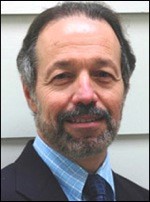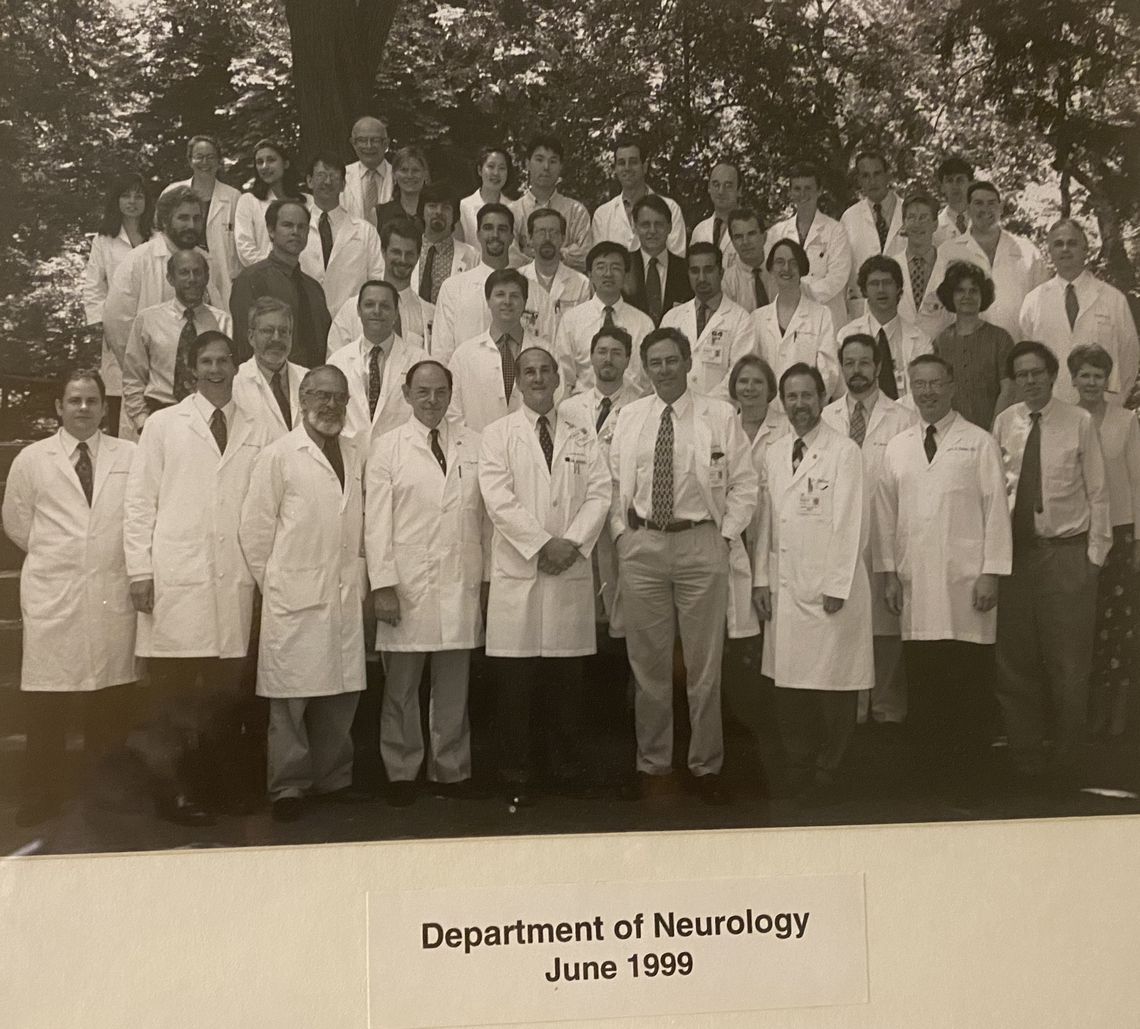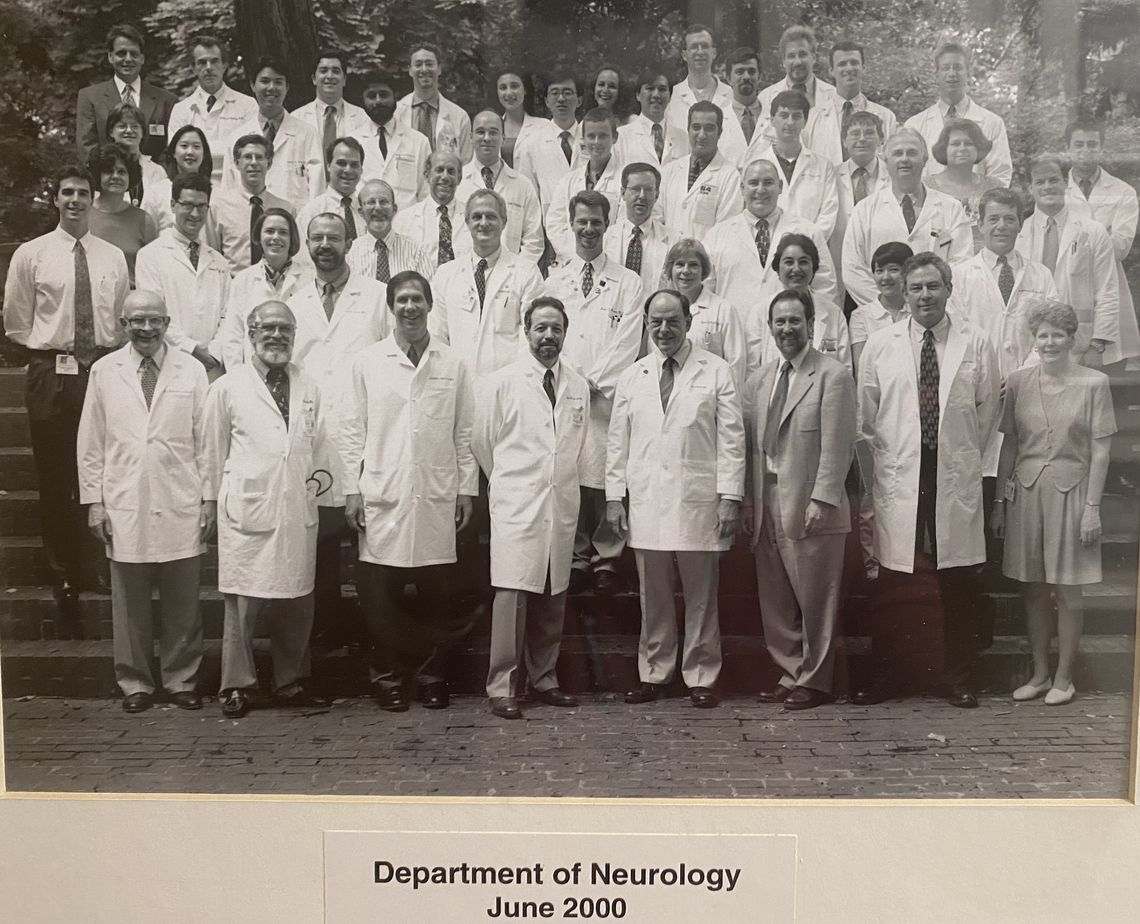- Our History
- The History of Neurology and Timeline
- Timeline
- Francisco González-Scarano, Chair
FACULTY INTERVIEWS
Dr. Grant Liu interviews Dr. Steve Galetta: Check out Steve Galetta talking about his experience as chair: Check out the full video here:Galetta Interviews: full and snippets
Francisco González-Scarano, Chair, 1999 — 2010
 Francisco González-Scarano, M.D. was educated at Yale (BA 1971), and Northwestern (MD 1975). He trained as an intern in Medicine and resident in Neurology at the Hospital of the University of Pennsylvania, was a post-doctoral fellow in the Department of Microbiology and jointly in Neurology at Penn between 1979-1981, following which he spent a year as a visiting worker at the National Institute for Medical Research in London, UK. He first joined the faculty at Penn in 1982 as an assistant professor of Neurology; he was tenured in 1988, promoted to Professor in 1994, and chaired the Department of Neurology 1999-2010, becoming Professor Emeritus in the summer, 2010. He held many leadership positions at Penn, including co-Director of the Penn Center for AIDS Research (CFAR), which he co-founded with Dr. Jim Hoxie, and co-Director of the University of Pennsylvania Comprehensive Neuroscience Center, also founded under his leadership. He was a member of the Executive Committee in the Clinical Practices of the University of Pennsylvania (CPUP) and an active participant in the Graduate Group in Cell and Molecular Biology. Dr. González-Scarano also led a vigorous and highly ranked department and expanded the faculty and importantly, the residency program. The undergraduate (medical student) clerkship in neurology was the highest ranked among the clinical clerkships at Penn during his tenure and the department was highly ranked for its NIH portfolio. Dr. González-Scarano became the Dean of the School of Medicine (now Long School of Medicine) and Vice-President for Medical Affairs at the University of Texas Health Science Center in San Antonio in August 2010; he was Executive Vice President for Medical Affairs in 2016. He stepped down from the deanship at the end of December 2016 and left the institution in August 2018, retiring from full-time academic life. Among his accomplishments in San Antonio were complete revamping of faculty compensation and state funds flow, reorganization of the medical school curriculum, and development of the medical school practice plan into a robust and growing organization. Dr. González-Scarano also participated in the transition of a regional health center into a medical school (now the UT Rio Grande Valley School of Medicine).
Francisco González-Scarano, M.D. was educated at Yale (BA 1971), and Northwestern (MD 1975). He trained as an intern in Medicine and resident in Neurology at the Hospital of the University of Pennsylvania, was a post-doctoral fellow in the Department of Microbiology and jointly in Neurology at Penn between 1979-1981, following which he spent a year as a visiting worker at the National Institute for Medical Research in London, UK. He first joined the faculty at Penn in 1982 as an assistant professor of Neurology; he was tenured in 1988, promoted to Professor in 1994, and chaired the Department of Neurology 1999-2010, becoming Professor Emeritus in the summer, 2010. He held many leadership positions at Penn, including co-Director of the Penn Center for AIDS Research (CFAR), which he co-founded with Dr. Jim Hoxie, and co-Director of the University of Pennsylvania Comprehensive Neuroscience Center, also founded under his leadership. He was a member of the Executive Committee in the Clinical Practices of the University of Pennsylvania (CPUP) and an active participant in the Graduate Group in Cell and Molecular Biology. Dr. González-Scarano also led a vigorous and highly ranked department and expanded the faculty and importantly, the residency program. The undergraduate (medical student) clerkship in neurology was the highest ranked among the clinical clerkships at Penn during his tenure and the department was highly ranked for its NIH portfolio. Dr. González-Scarano became the Dean of the School of Medicine (now Long School of Medicine) and Vice-President for Medical Affairs at the University of Texas Health Science Center in San Antonio in August 2010; he was Executive Vice President for Medical Affairs in 2016. He stepped down from the deanship at the end of December 2016 and left the institution in August 2018, retiring from full-time academic life. Among his accomplishments in San Antonio were complete revamping of faculty compensation and state funds flow, reorganization of the medical school curriculum, and development of the medical school practice plan into a robust and growing organization. Dr. González-Scarano also participated in the transition of a regional health center into a medical school (now the UT Rio Grande Valley School of Medicine).
Dr. González-Scarano laboratory work was in HIV neuropathogenesis and other aspects of neurovirology, bunyaviruses, and brain inflammation, particularly the role of microglia in HIV infection of the CNS, including defining their HIV receptor and co-receptor. Additionally, together with colleagues Donald Silberberg, Steve Galetta and Robert Grossman he described the use of gadolinium for the analysis of multiple sclerosis demyelinating activity. This work was expanded into other MRI modalities used to detect white matter abnormalities both clinically and experimentally.
Continually funded by the NIH since he joined the faculty, his laboratory was closed when he became dean in 2010, leaving behind to colleagues NIH grants including one RO1 and two training grants. Prior to that, he was the principal investigator of many NIH grants; at the time of becoming Chair, he was the principal investigator of two program projects, two RO1 grants, and two training grants. He also was a Harry Weaver Neuroscience Scholar of the National Multiple Sclerosis Society during his first five years on the faculty. Dr. González-Scarano held many roles in national organizations, is the author of many publications in neurovirology, AIDS, and Multiple Sclerosis, and is co-editor of two books. According to Google Scholar, his scholarly work has been cited 14,750 times. Between 1993 and 1997 he was the Chairman of the Board of Scientific Councilors of the NINDS; before and since he has served on several NIH and Multiple Sclerosis Society study sections. He was on the Council of the American Neurological Association in 2001-2003, chaired its Scientific Program Committee, and was its first vice-President 2008-2010. He was a member of the National Advisory Neurological Disorders and Stroke Council (2004-2008) and is an elected member of the National Academy of Medicine (2006), serving a term on its Nominating Committee. In 2015 he was named a Distinguished Alumnus of the Feinberg (Northwestern) School of Medicine. In addition to his clinical work in Multiple Sclerosis and his laboratory activities, he was on the Editorial Boards of the Journal of Virology, Virology, Virus Research, the Journal of Neurovirology, Glia, and AIDS. He currently edits a section of the electronic textbook.
After leaving full time academic practice Dr. González-Scarano and his wife, Dr. Barbara J. Turner – a 2022 recipient of the Women in Medicine award from the PSOM– moved to the LA area to be closer to their grandchildren. Dr. González-Scarano joined the clinical faculty at the University of Southern California as a part-time Professor and practices and teaches neurology residents at the safety-net Los Angeles County Hospital.
Educational Highlights
- Under the leadership of Dr. Amy Pruitt, the Neuro 200 clerkship was consistently rated in the top 3 among the SOM core clerkships, and frequently #1
- Merger of PAH and HUP neurology residencies and sequential expansion to 9 adult residents/year by 2010
- Consolidation of CME courses under one faculty leader (Liu)
References and Sources:
Chair photo: https://www.med.upenn.edu/apps/faculty/index.php/g275/p14284 (However, the current picture from the summary document is too small to use)
Major Discoveries and Events at Penn during this time
- 2004 - On January 27, 2004, Trustee Chair James Riepe announced the selection of Dr. Amy Gutmann, then Provost of Princeton University, as the eighth President and Chief Executive of the University of Pennsylvania; the University Trustees formally approved her appointment at their February 20th meeting. When Dr. Gutmann took office on July 1, 2004, she became the second woman president of the University of Pennsylvania. Official inauguration ceremonies took place on October 15, 2004.
Major Translational Research and Clinical Advances during this era
- The department was generally in the top 10 departments of Neurology for NIH funding (one year it was #1). Research base – including DOD and State of Pennsylvania – reached $20M
- Neurology laboratory space in Johnson Building, 4th floor was renovated.
- Successfully collaborated with Neurosciences to develop joint space to enhance programmatic synergies (Taylor, Balice-Gordon)
- Identification of anti-NMDA encephalitis as a specific entity, now recognized as the most common autoimmune encephalitis
- Development, jointly with Neuroscience and with CHOP, of the Center for Dynamic Imaging of Nervous System Function
- Development jointly with Radiology, of the Center for Functional Neuroimaging, a type I center in the Department of Radiology, headed by Dr. John Detre
- Establishment of a research project requirement for all residents.
- Funding of Research Training Program in Disease Oriented Neuroscience (R25) for residents. Dr. González-Scarano helped conceive of the program while on the NANDS Council, developed the Penn application, and was the PI at Penn until his retirement from Penn (Dr. Detre then became PI).
- Establishment of the Parkinson’s Disease Research, Education and Clinical Center (PADRECC) at the Philadelphia VA Hospital
- Creation of division of General Neurology
- Decreased overhead to increase remuneration for clinical activity
- Expansion of the clinical faculty and continuing increase in admissions, and outpatient visits during the decade
- One of the highest US News rankings for the health system (together with Neurosurgery) and an important contribution to HUP’s position in the US News & World Report designation as an Honor Roll hospital
- Expansion of the epilepsy program in collaboration with the School of Engineering and development of faculty member with a joint appointment, Brian Litt.
- Development of a Pediatric MS program in collaboration with CHOP
- Global Programs - Development of clinical rotations in Botswana for Neurology Residents
- Development of Philanthropic Funds to support clinical activities and clinical research
- Elliot Chair
- McNeil Family Fund in Multiple Sclerosis
- Figge Fund in Cerebrovascular Disease
- Rich Fund in Parkinson’s Disease and other movement disorders
- Parker Fund for the Center for Functional Neuroimaging
- Barrist Fund for Cognitive Neurology
People of this era
Relevant DEI Faculty as of 2009-10 (Asst Professor and above) ?
- Balcer, Laura Professor (Promoted FY09)
- Berqvist, Christina Assoc. Professor (Promoted FY09)
- Chen-Plotkin, Alice Asst. Professor
- Dahodwala, Nabila Asst. Professor
- Elman, Lauren Asst. Professor
- Horn, Stacy Asst. Professor
- Ichord, Rebecca Assoc. Professor (Promoted FY09)
- Jacobs, Dina Asst. Professor
- Kumar, Monisha Asst. Professor
- Lawler, Kathy Asst. Professor
- Lewis, Sharon Asst. Professor
- Park, Soojin Asst. Professor
- Porter, Brenda Asst. Professor
- Pruitt, Amy Assoc. Professor
- Rosenfeld, Myrna Professor (Promoted FY09)
- Sapin, Joyce Asst. Professor
- Schmitt, Sarah Asst. Professor
- Smith, Sabrina Asst. Professor
- Venkat, Anu Asst. Professor
- Wilkinson, Jayne Asst. Professor
- Geoffrey Aguirre Asst. Professor
- Ernest Barbosa Assoc. Professor
- Roy Hamilton Asst. Professor
- F. González-Scarano Professor
- Continued the development of ICU together with Neurosurgery and Anesthesia and recruitment of a neuro-intensivist (Levine) to run this unit together with a senior member of the Department of Anesthesia
- Recruitment of neuro intensivists: Kumar, Park
- Decreased overhead to increase remuneration for clinical activity
- Neuro-Oncology recruitments and expansion of service and research in the area
- Recruitment of a group of an outstanding adult then junior clinicians including Drs. Cucchiara, Duda, Elman, Herman, Kleiner-Fisman, Jacobs, Levine, Lewis, McGarvey, Messé, Price; complemented by outstanding clinical pediatric neurologists, Bergqvist, Ichord, Licht, and Mason.
- Recruitment of Dr. Eliot M. Wallack as a full-time clinician initially based at CCA, a new paradigm for the departmental faculty
- Recruitment of several clinician-scientists (Aguirre, Cooper, Chen-Plotkin, Raizen, Taylor)
- Development of a research (and clinical) Neuro-oncology program including the recruitment of a senior, internationally renowned researcher, Dr. Josep Dalmau, and his co-worker, Dr. Myrna Rosenfeld
- Expansion of the cognitive Neurology program to one of the largest in the country by recruitment of a senior investigator, Dr. Branch Coslett, as head of the section, and of a junior faculty member, Dr. Geoffrey Aguirre, mentioned previously. Planned move of the Cognitive Neurology Division to the Richards-Goddard Building
See Department Photos from this Era


 Annual Group Photo’s (Gonzalez-Scarano Era)
Annual Group Photo’s (Gonzalez-Scarano Era)